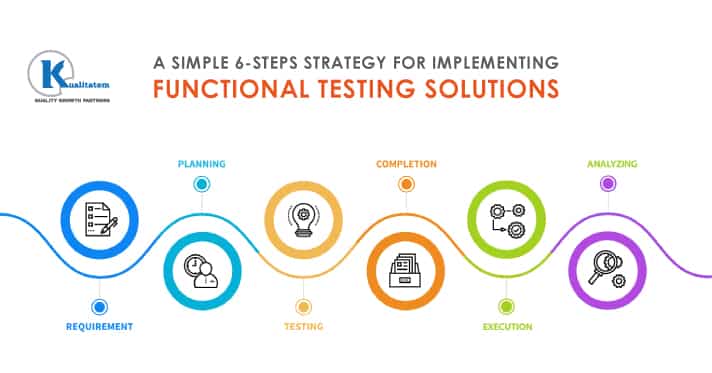Implementing Functional Testing Solutions: A Simple 6-Step Strategy

- December 11, 2018
- HibaSulaiman
Just a few years back, Quality Assurance wasn’t considered a meaningful career path to choose. Rather, it was considered as basic level R&D, with a low budget and attention-deficit area. Worst case scenario was that QA engineers were reflected as the biggest enemies of developers.
Today, on the other hand, the odds have changed. QA is considered a requisite component of software lifecycle development process. Organizations have come to realize how an application product or website’s quality has a direct impact on the brand’s reputation and customer satisfaction.
For example, in the agile environment, QA engineers are not limited to focus on testing alone, but, in fact, have an important role to play in the planning as well as the delivery stages. The shift left paradigm—which emphasizes on testing to be performed earlier in the lifecycle as opposed to being performed at the very end—calls for QA engineers to potentially possess technically-sound skills and thorough understanding of the CI/CD practices.
Though, QA managers, who typically favor integration in the scrum team, in addition to rapid feedback on user stories and automation, must not overlook the primary objective behind quality engineers, i.e., a high-quality end-product and a smooth-sailing user experience for customers.
For high quality, testing and verification are mandatory. Although there is a list of QA testing types that can be executed to accomplish quality goals. Among them, Functional Testing is one of the most important quite types and also the most sophisticated and comprehensive one.
Functional testing solutions focus on testing features or functionality of a website or software product. In order to test the functionality, a set of inputs are provided to observe if the outputs received are in accordance with what is expected.
To simplify the procedure, we have created a simple 6 steps strategy for implementing functional testing solutions. Read down below:
1. Gather information to prior to testing:
Before you begin testing, it is important to know what needs to be tested and what strategic plan or procedure to adopt for testing. You can get information about critical user commands and processes from the development team before you begin testing the most critical areas.
Knowing about the latest market demands for product development and what the customer insists to have is essential to begin testing. Once vital information has been gathered, prepare a document or matrix that links the product to the requirement and test cases. This matrix is subject to changes as per changes in the requirements.
2. Prepare test plans and test cases:
Following the documentation, you need to prepare a test plan that highlights your testing objectives as well as the scope of testing, hardware and software tools, number of testers involved and a schedule for testing. This plan should also include the number of test cases that need to be written. Additionally, rank these test cases in accordance with the priority for reducing delay and risk. Also, make sure that the development team reviews these test plans before you execute them.
3. Test execution time!
Test plans…check! Test cases…check! It’s time to execute these tests then. Make sure that the test cases are written are easy to modify if necessary according to the changing demands while testing. All the while testing is being performed, make sure to document the problems faces and write solutions to those problems as well.
4. Take up automated testing
Automated testing helps to improve the quality of the product or website and also cuts back on testing time to 40%. However, the tester takes the decision to decide what needs to be automated and what can be check manually. Since test automation is slightly higher in cost compared to manual testing, nonetheless, it proves to be more beneficial for the product in the long run.
5. Manage defect logs using a data repository
It has been witnessed that testers, while working on the same functionality, may report the same defects, arrange an incorrect order of defect fixing, etc. The only way to avoid this problem is to manage your defect logs or reports within a central data repository that is shared across with other testers working on the same project.
6. Reporting and analyzing of test results
A test result is prepared in a particular format that includes a detailed summary of status and progress all the test cases that were executed along with time stamps against each feature. The report should be readable and understandable enough for the development team to work on fixing them. Following the reporting, the QA and development team sits together to improve on the areas that need to be fixed.
These simple 6-steps strategies make for flawless functional testing solutions that you can deliver your clients.











